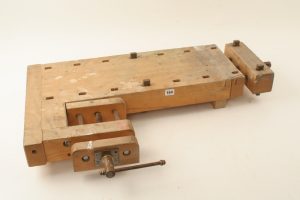We may receive a commission when you use our affiliate links. However, this does not impact our recommendations.
An eagle-eyed reader spotted this small benchtop that looks like the bigger Danish brother to the portable Milkman’s Workbench I wrote about in the June 2013 issue of Popular Woodworking Magazine.
This benchtop was made by LEVARD, a company in Denmark that still manufactures workbenches. I’ve seen LEVARD workbenches in Europe and even the United States. They are distinguished by their unusual tool trays, which are not usually part of the benchtop proper.
This portable benchtop, which is for sale in an upcoming David Stanley auction, doesn’t appear to be made by LEVARD anymore. At least, I cannot find it on the company’s English-language site.
I also am not sure if it was intended to be a portable benchtop, like the Milkman’s Workbench. I have seen this top in a couple places that was attached to a spindly base. It would be difficult to use this bench if clamped to a kitchen cabinet or dining table because the rear row of dog holes would be rendered useless.
But other than that gripe, it’s a pretty cool little bench. If you own one like it, let us know in the comments.
— Christopher Schwarz, who still has a thing for workbenches.
Read other posts about the Milkman’s Workbench via this link.
Here are some supplies and tools we find essential in our everyday work around the shop. We may receive a commission from sales referred by our links; however, we have carefully selected these products for their usefulness and quality.










I ended up buying this workbench top on Friday at the David Stanley auction, for £35, to use as a mobile bench for shows and in my small shed workshop. If you register at http://www.britishwoodworking.com/bulletin you can receive a free update on how I get on with it. I intend to build it a reasonably substantial base. I’ve never much cared for end vices, so it will be fascinating to see how I get on with it. There are quite a few holes in the top, and I can’t tell if they are from a drill or worm.
Interesting to note that while Chris refers to the unit by the name “LEVARD”, all the info and links refer to LERVAD.
I first heard about them in the late 50’s from our metalwork teacher who was Scandinavian.
Just another eagle-eyed observation.
I have the Lervad Carver’s Bench, a 132mm long version, bought about 30 years ago. The folding base was about as sturdy as your typical card table.
I have added 7+ inches to the width (now a 52″ x 18″ top) and replaced the base with a Scandinavian-style base… much more stable. A couple of hundred pounds of wheelweights on the lower shelf add mass, and I am building a drawer unit. The removable tool tray now hangs on the wall nearby.
This bench serves me well for small-item projects… boxes and trays.
I think you will find it at this Lervad web site http://lervad.co.uk/products/242-single-technology-bench/286-technology-bench-80-cm—open-frame/
apparently they still produce a similar bench: if you do not assemble the legs and tool tray of this model, that’s pretty much what you have on your photo : http://lervad.co.uk/products/242-single-technology-bench/286-technology-bench-80-cm—open-frame/
I to had my first woodworking experience at one of those workbenches at school, and later got my hands on one so when my son gets older, he will have a good bench to start him of, and hopefully his future passion.
I have got one of those at home for the children to work at.
Like Niels Christensen said, it is commonly known as a slojd bench.
I never remember them as spindly since the back is always against something. Normally in the school that would be the 19 common tool tray that forms the back of the 19 other benches.
In my workshop, the children’s workbench has the back against the wall.
You will find around 10 or 20 of those benches in the slöjd room, of every danish folkeskole (grades 1-10). They are one of lervads Group technology bench’s (80 cm). Had my own first woodworking experience on one of thoose.
Did a trivet…..